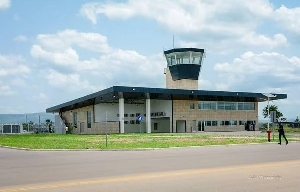 The Ho Airport generated no revenue but had an expenditure of GH¢1.38 million in 2024
The Ho Airport generated no revenue but had an expenditure of GH¢1.38 million in 2024
A report by the Auditor-General’s office has revealed underwhelming financial outcomes for the country's five regional airports.
According to the latest Auditor-General’s Report on the accounts of public boards, corporations, and other statutory institutions in 2023, these airports generated a combined revenue of GH¢13.13 million in 2022, against an expenditure of GH¢39.14 million.
This resulted in a significant deficit of GH¢26.01 million, prompting a re-evaluation of strategies to optimize regional airport development and maximize economic benefits.
The regional airports in question are Kumasi Airport, now Prempeh I International Airport in the Ashanti Region; Tamale Airport in the Northern Region; Wa Airport in the Upper West Region; Sunyani Airport in the Bono Region; and Ho Airport in the Volta Region.
A detailed breakdown of the data revealed that Kumasi Airport incurred an expenditure of GH¢15.68 million but generated only GH¢8.22 million in revenue. Similarly, Tamale Airport brought in GH¢4.74 million in revenue but had a substantial expenditure of GH¢15.41 million.
Sunyani Airport earned GH¢95,626.58 in revenue after an expenditure of GH¢4.53 million. Surprisingly, Ho Airport generated no revenue but had an expenditure of GH¢1.38 million in 2022. Wa Airport generated GH¢77,250.48 in revenue while investing GH¢2.15 million in its operations.
The Auditor-General, Johnson Akuamoah Asiedu, attributed the unimpressive performance of the regional airports to low passenger patronage, the limited number of domestic airlines currently in operation, and the underutilization of airport rentable facilities or space for non-aeronautical revenue. The report highlighted that all five regional airports were not commercially viable, affecting the Ghana Airports Company Limited’s (GACL) finances due to low revenue generation compared to the high operational costs.
The report warned that underutilized airport facilities, such as those at Ho Regional Airport, could lead to the deterioration of the infrastructure. To address these issues, the Auditor-General recommended that GACL management encourage existing and potential domestic airlines to patronize the airports by providing possible incentives. Additionally, a publicity drive to promote and market these airports was suggested to encourage more air travelers to use the regional airports.
Furthermore, the Commercial Service Department of the GACL was advised to identify potential concessionaires to occupy idle spaces to generate more revenue through rent and royalties. The report also recommended that GACL management liaise with appropriate regulatory authorities to reduce regulatory barriers for potential airlines without compromising safety.
In response, the management of the airports admitted that none of the regional airports were commercially viable. However, they expressed optimism that with new infrastructure and the commencement of international operations, some of the airports in the regions could become viable. The GACL emphasized that the creation of these non-commercially viable regional airports is a national policy and that developing the infrastructure at these airports would create significant job opportunities during and after construction.
The GACL also highlighted its responsibility for providing related social and public services in all regions of the country from its own resources. The company is required to invest significantly in all the regional airports, including those in Kumasi, Tamale, Sunyani, Wa, and the new airport at Ho, contributing to the country's economic development.
GA/BB